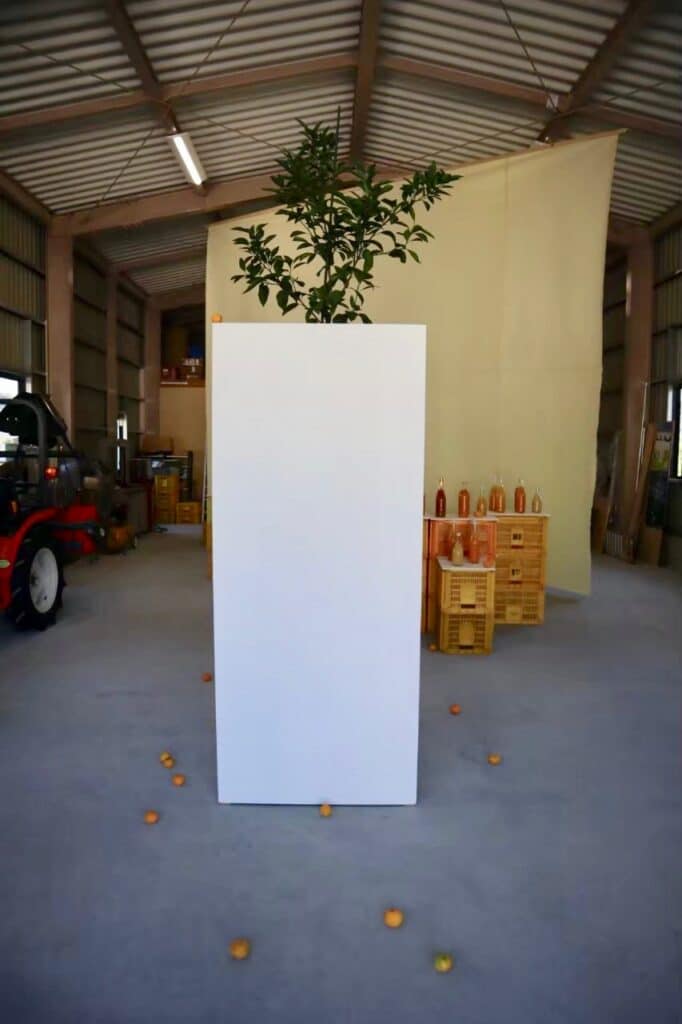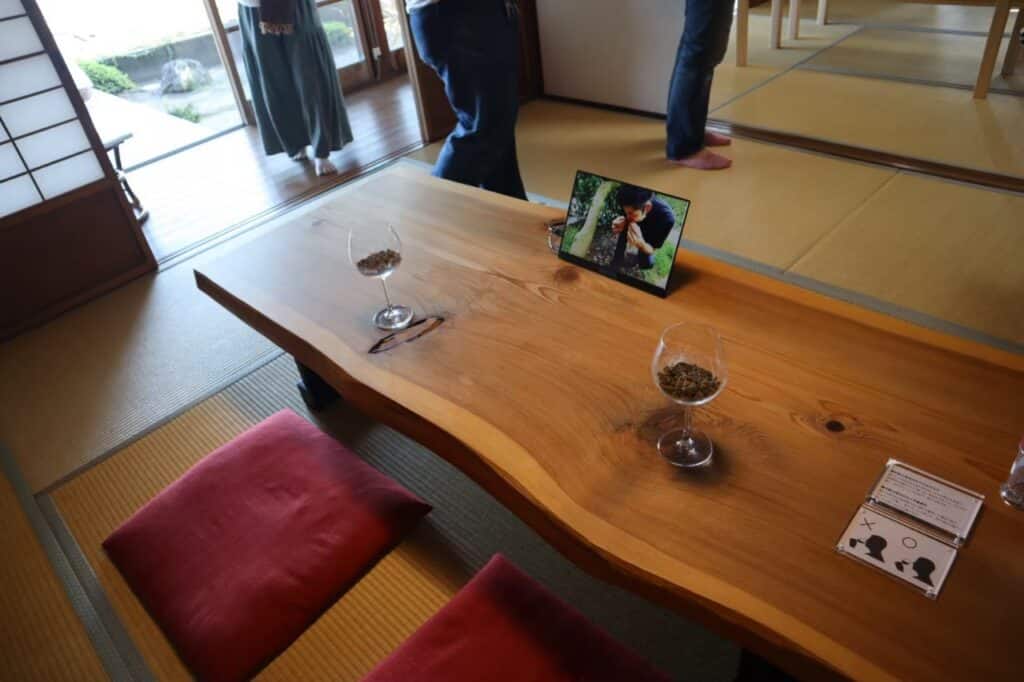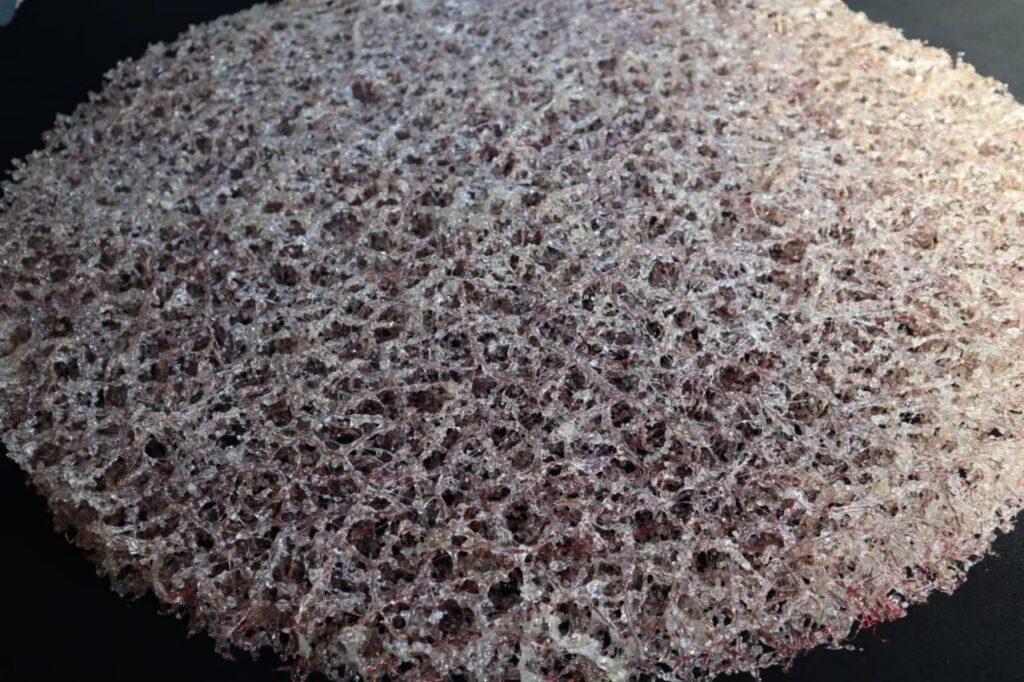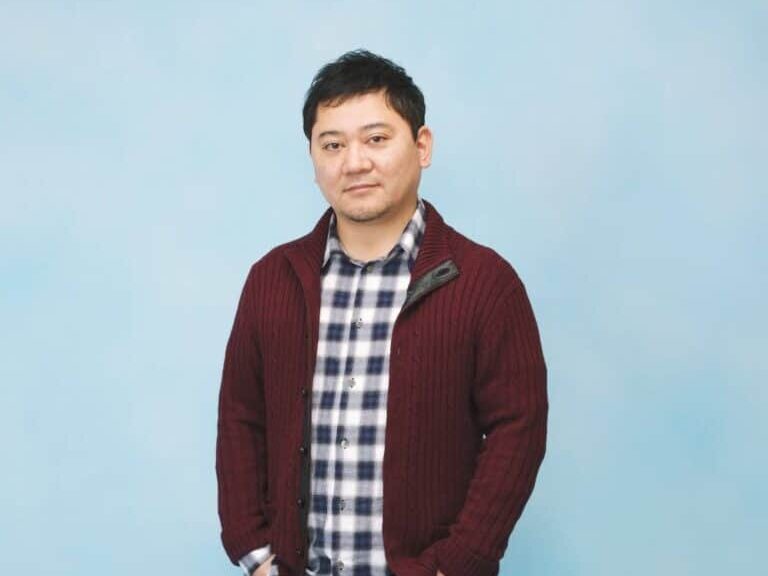Orange Collective

The Brilliance of the Citrus Fruit of the Alternate Dimension
On the Idea of a Mandala that Transcends Monolinear/Single-layer Space-time
Taisuke Karasawa
Associate Professor, Akita University of Art
1. 非時香菓 –Tokijiku-no-Kagunokonomi –
The origin of the Japanese citrus fruits with which we Japanese are familiar is said to be the Tachibana (also known for Citrus tachibana, Yamato Tachibana and Nippon-tachibana). In the Chronicles of Japan (J.Nihon Shoki), the citrus fruit is referred to as Tokijiku-no-Kagunokonomi (非時香菓).
(Suinin Tenno) 90th year,1 Spring, 2nd month, 1st day. The Emperor commanded Tajima-no-Mori (田道間守) to go to the Eternal Land (J. Tokoyo-no-Kuni) and retrieve the fragrant fruit, Tokijiku-no-Kagunokonomi that grows out of season, now called the Tachibana. (The Chronicles of Japan, Nihon Shoki). (Vol.6, Article on the first day of the second month in the 90th year of Emperor Suinin Reign, A.D. 61).
Tajima-no-Mori is a legendary figure in the Nihon Shoki and the Record of Ancient Matters (J. Kojiki) and is also regarded as the ancestral deity of citrus fruits. He is said to have been ordered by Emperor Suinin to search for this Tokijiku-no-Kagunokonomi in the Eternal Land, which is believed to be the fruit of the Tachibana as we know it today. From the beginning of recorded history, it was believed to be the fruit of immortality.
It is found not only in the Nihon Shoki, but also in the Kojiki, Japan’s oldest surviving historical record. I believe the fact of both sources stating that the Tachibana was grown in the Eternal Land is extremely important. The Eternal Land was believed to be somewhere beyond the sea, the land of the dead, and another world.2 It is, so to speak, another parallel universe, or a place that far transcends the real world (three-dimensional space) we normally recognize. It is in such a place that the Tokijiku-no-Kagunokonomi bears fruits.
Normally, the Tokijiku-no-Kagunokonomi is often interpreted to be a fruit that is aromatic at any time of the year. Given its place of origin (Tokoyo-no-Kuni), this is a logical conjecture.
The time that flows in the Tokoyo-no-Kuni is not the time of this world. Thus, our world’s view of time and logic cannot be applied to this place. Tokijiku-no-Kagunokonomi (非時香菓)’s Chinese characters contain “非 – non,” and “時- time” – meaning time without time in Japanese. In addition, the aroma “香” infuses the surroundings, and the golden sweets “菓 Ka” (the same pronunciation as “果 Ka”– fruit) are exalted as spiritual fruits, so divine that they cannot be considered to be of this world. These traits might make one believe that if one ate it, one could attain immortality. Of course, in order to become immortal, one must transcend the time and space of this world. It is highly suggestive that Tajima-no-Mori found a suitable fruit for the emperor’s request in the other-dimensional space of the Tokoyo-no-Kuni. Here, I take a further leap of imagination. Tajima-no-Mori (田道間守) may have been a person with magical background. Indeed, the Chinese characters for his name ‘道 -road’ and ‘間- between’ intimate he was able to move between the Tokoyo-no-Kuni and the real world.
Orange Mythology VR (2022) (Photo 1) by Kosuke Tanabe, exhibited at tanabe en +, was a visualization of this other-dimensionality. The viewer wears VR goggles and enters the inside of an orange floating in the macrocosm. The “I” and the subjectivity of oranges are intertwined, and the viewer experiences a floating sensation, being in the midst of a twisting of time and space.
Incidentally, tanabe en + was also the information center for this past year’s Kinan Art Week Exhibition. It functioned as a doorway to another world, ‘Orange Mandala’. Visitors were handed a map of each exhibition venue, almost as if it were a guide map showing the location of the fruits of the ‘Tokijiku-no-Kagunokonomi‘.
The Tachibana dissolves normal spatiotemporality. This important aspect of transcending Monolinear/Single-layer Space-time, intuited by the ancients, could still be thought to characterize oranges today. Yuto Yabumoto, chairperson of the Kinan Art Week Executive Committee, must have keenly sensed this intuition. The place called Kinan, where descendants of this fruit from another dimension grow, is certainly connected to ‘the other side.’ Yabumoto then attempts to deeply explore the meaning of this spiritual and magical fruit through meticulous fieldwork and literature review.
In Yabumoto’s view, the Tachibana delinks (shown as 断ち- tachi) ‘cosmos’ and ‘chaos,’ and it “stands” (shown as 立ち – tachi) between the ground of Takamagahara, a High Plane of Heaven of this world and the Eternal Land (Tokoyo-no-Kuni)3 [Yabumoto 2022: Kinan Art Week website]. However, the situation may be more complicated because the Tachibana was originally discovered in the Eternal Land. In other words, it is a fruit from the other world. It is important to remind ourselves that the other world, Tokoyo-no-Kuni, contains a transcendental force beyond the ‘logic’ of the real world. The tree that grows in the field beyond human knowledge is imbued with a mighty and matchless sanctity. The tree, like the tree of Life in the Garden of Eden, is inherently not even touchable by humans. The sharp thorns on the young trunk of the Tachibana tree seem to symbolize its sanctified status.
2. Fruits, Soil, Roots and Branches
In Satoshi Hirose’s installation il giardino dei sensi – the garden of the senses – (2022) at the Yui Warehouse, a young mandarin orange tree (Photo 2) growing out of a giant wooden box caught my attention. The white rectangular box amplified the sacredness or primordiality of oranges, transcending our ‘logicalness faculties’. The visitors could only look up at the sapling of the orange tree peering out from the top of the white box. At the same time, the unique aura created from the contrast between white and green emanates a vivid sense that this is not just a fruit, but rather a spiritual fruit. Another work by Hirose at SOUZOU, Torre della frutta – fruit tower – (2022) (Photo 3), resembles a Shinto altar. The visitors were instructed that they may freely pick and eat fruit from the exhibited orange trees planted there. However, a strange conflict arises. When the viewers faced this ‘tower,’ they felt a sensation as if they were touching an offering dedicated to deities or holding the fruit of a forbidden tree. In other words, the viewer felt the sacredness or primordiality of the oranges through their cutaneous sense. Then, when the viewer reaches out to grab the fruit, they unconsciously smell its scent. The plush fragrance must have extended to their brain.

It is not only the fruit that is aromatic. The soil in which the citrus fruits grow is also scented. basilli × Caravansarai – Scented Soil – (2022) (Photo 4) by basilli, exhibited at Aiwaso, was a work where visitors could feel the very living soil through their sense of smell. The soil was placed in a deep wine glass. Although I had never experienced this scent before, it was somehow nostalgic. Perhaps this nostalgia might be connected to the roots of mankind. Since our birth, mankind has lived by placing our feet flat on the ground, and this fundamental principle still remains the same even today. In this sense, the soil can be said to be the closest ‘existence’ to us. According to the Old Testament, it is said that God created Adam, the ancestor of mankind, from dirt. And our excrement, flesh and bones eventually return to the soil. Soil could be thought of as the fundamental starting point in this cycle.

Citrus fruits may differ decisively from humans in that their roots, as the part of their body, are always burrowing underground. However, in order for humans to survive, we must stand above the ground. In contrast, citrus trees must also shelter in the soil. Their wriggling under the soil profoundly stirs our imagination. Be Takerng Pattanopas within/without #3 (2020) (photo 5), exhibited at SOUZOU, was like a transparent root, or even like a neuron in the brain. Normally, roots exist in the soil and neurons exist in the brain, and these complex and bizarre networks can not simply be visualized from within. However, one could imagine them, for some reason, suddenly becoming externalized. Systems that have been hidden before, suddenly appearing in front of our eyes without any intermediary, with us becoming perplexed because we are unable to define it within our knowledge framework. One could imagine the same with, for example, a slime mold’s plasmodium. When we suddenly happen to see this complex and bizarre ‘it’, which we cannot perceive in our everyday life (we can even say that it is not in our Umwelt),4 we could even become delusional: “Could this be an alien invasion?” 5 [Sharp & Graham 2017: 30]. Incidentally, recent research has shown that the networks of slime mold and the macrocosm are very similar in their shape.6 In other words, this internal complex network is in real resonance with the external macrocosm.

The inside leads to the outside and the outside leads to the inside. The sound art unit AWAYA attempted to express this structure using ‘sound.’ In their installation Sound Torus of Mandarins and People (2022) (Photo 6), which was exhibited in SOUZOU’s warehouse, environmental sounds (that the mandarin oranges would have ‘heard’ during their growth process: wind, water, the sound of lawn mowers, etc.) were streamed into the interior of the tree branches. By attaching their ears to the branches, visitors could hear the sounds as if they were bone-conducted by the slight vibrations. Of course, the orange tree branches do not have an organ like the human ear, but they must still have always ‘heard’ the environmental sounds. Perhaps, these sounds were echoing inside the tree. This work was produced on such an assumption. The experience of hearing sounds that originally sounded outside the tree inside the tree branches confounds our concept of outside and inside.

3. Mandala
The citrus fruit is, primordially, beyond the ‘logic’ of this world. Its sanctity stimulates not only our sense of sight, but also our senses of smell and hearing. The exhibition at each venue was like a device that amplified the viewers’ perceptual information. The viewers were then caught up in the vortex and experienced a twist in time and space. Being on the locus of the spiritual world is the only place where people can taste the ‘juice’ that overflows from that twist. Or, when we immerse ourselves in a spiritual world, it is as described by D.T. Suzuki (1970-1966):
In this spiritual world there are no temporal divisions such as past, present or future. All is set in the quivering present when life is in the place of its true meaning–the past and the future are both condensed into this present moment of brightness. [Suzuki 1955: 70]
Where and how can we find this ‘present moment’ that transcends past/present/future in which everything is condensed? It is difficult for us humans to understand space and time with our rational mind, and five physical wits. Rather, it is something that can be seen only after thoroughly disarming them.
The Kinan Art Week and Futakawa Chōgakko found this worldview or cosmology in Tarō Okamoto (1911-1996). So, they organized a screening of the movie, Tower of the Sun (Director: Kosai Sekine, 2018) and a talk event at tanabe en + during the exhibition. The visual affinity between the citrus fruits and the sun has often been noted since ancient times, and the theme of the screening and talk event that followed was to bring the two elements together on a more meta-level by valuing the idea of “mandala” as a medium.
It is well known that Tarō was greatly influenced by the idea of the Mandala in the production of Tower of the Sun. This is also shown in the film. Tarō perceived the Mandala as something that “denies space and denies history away” [Okamoto 2015: 236]. In addition, he denounces our modern ways as being “reliant too much on the concept of space and depending on time” [Okamoto 2015: 236]. Tarō had a strong desire to dismantle our optimism for science and value for historical preservation that we have created in our modern society. This will is also reflected in the Tower of the Sun.
Tarō’s idea of the mandala was of a device to remove the shackles of the concept of time and space that form the basis of human perception. Moreover, it was both a model and theory that gave us a real sense of the ‘wonder’ that lies beyond the three-dimensional nature of life. The Tower of the Sun is a perfect embodiment of this conception. There is a ‘world of spirituality’ as a ‘present moment’ that encompasses everything. Like Tarō, I believe that the Jomon people must have lived in this concept of time and space. On the other hand, one might wonder if we, in modern times, have obliterated this rudimentary sense of time and space that enriches our lives? How symbolic that Tarō’s ‘Sun of the Underground’, which best represents this fertile idea of time and space, disappeared after the Expo ended.7
The Orange Mandala Exhibition may have been an attempt to re-illuminate the ‘Underground Sun,’ which denies a monolinear and monolayered concept of space and time. Alternatively, it could be thought of as a work to recapture and place the orange as once again being a “Tokijiku-no-Kagunokonomi,” using the concept of the “mandala.” Of course, this is not just physical “brightness.” As Yabumoto points out in quoting the words of Kenji Nakagami (1946-1992) [Yabumoto 2022: Kinan Art Week website], it is not a ‘brightness’ that aims only at the multiplication of material wealth, but a Susanoo-like ‘brightness’ that is the king of the underworld called Nenokuni–root country. This subterranean brightness is unmistakably the radiance of the ‘Sun of the Underground’.
1. It is quite difficult to convert the era of the ancient emperors, but if you calculate the 90th year of Emperor Suinin, it would be 61 AD. Almost 2000 years ago (of course, the Tachibana would have already grown wild before then).
2. Even if Tokoyo-no-Kuni specifically referred to countries across the ocean (mainland China and the Korean Peninsula), its fundamental significance, that is, the importance of the other-dimension spatiality implied therein does not change. It was much more of a frightening terra incognito than we may imagine today.
3. Yabumoto states that the Tachibana’s “tachi” has a double meaning in Japanese. One is “立ち- tachi- to stand upright” as “Nature’s workings stand up conspicuously” and the other is “断ち – tachi- to block something” as cutting off “chaos and negativity” by standing on the ground between Takamagahara and Yominokuni – the world of the dead [Yabumoto 2022: Kinan Art Week website].
4. The Kinan Art Week 2022 “Orange Mandala” official pamphlet states, “This work, produced during the Covid crisis, looks like an aggregation, like cells and slime mold, and also looks like a universe composed of countless stars.” [Kinan Art Week 2022: 4]. I don’t know if Pattanopas knows about slime molds or Kumagusu Minakata(1867-1941, Slime mold researcher, naturalist). However, the shape of Pattanopas’ work is just like a deformed slime mold that shines and wriggles.
5. In May 1973, a giant slime mold called Fuligo septica was discovered in the garden of a private house in Dallas, Texas. Rumors spread that this was an alien attack, and this incident caused mass panic to spread throughout the United States. [Sharp & Graham 2017:30].
6. For example, Joseph N. Burchett of the University of California, Santa Cruz and his colleagues focused on the network structure that slime molds exhibit during predatory behavior, and tried to apply the dynamics they discovered to create a three-dimensional space map. [Burchett 2020].
Works Cited
Burchett, Joseph N., et al. “Revealing the Dark Threads of the Cosmic Web.” The Astrophysical
Journal, vol. 891, no. 2, 2020, https://doi.org/10.3847/2041-8213/ab700c.
Okamoto Tarō. Shinpi Nippon [Mysterious Japan]. Kadokawa, 2015.
Sharp, Jasper, and Tim Grabham. Nenkin: Chisei no Hajimari to Sono Saiensu [The Creeping
Garden: Irrational Encounters with Plasmodial Slime]. Edited by Shin’ichi Kawakami. Translated
by Takeshi Ehara, Seibundo Shinkosha Publishing Co., LTD, 2017.
Suzuki, Daisetsu T. Kegon No kenkyū [Kegon Research]. Hozokan Corp., 1955.
Yabumoto, Yuto. “The Myth of the Orange.” Kinan Art Week, Kinan Art Week, 15 May 2022,
https://kinan-art.jp/en/info/6987/. Accessed Nov. 2022.

Taisuke Karasawa
Born 1978 in Kobe, Hyogo Prefecture, Japan, Karasawa graduated from the Faculty of Letters, Keio University in March 2002, and completed his Ph.D. (Doctor of Philosophy) at the Graduate School of Social Sciences, Waseda University in July 2012. He was a grant-in-aid researcher for the 1st Kumagusu Minakata Research Encouragement Project. After working as a JSPS Research Fellow (DC-2 [Philosophy and Ethics]) and as an assistant professor at the School of Social Sciences, Waseda University, he is currently an associate professor of Course of Arts & Roots and the Graduate School of Transdisciplinary Arts, Akita University of Art.
He specializes in philosophy and cultural anthropology. In particular, he explores the fundamental ‘way of being’ of folklore, religion and culture that has been built up by mankind through the thought of the intellectual giantKumagusu Minakata (1867-1941). In recent years, he has also been conducting comparative research on Minakata and artistic thinking, as well as on the contemporary potential of Kegon thought. In 2019, he was awarded the 13th Yasuo Yuasa Writing Prize.
Editor/Translation: YABUMOTO, Yuto
Translation: YAMAMOTO, Reiko
Localization: STRUCK-MARCELL, Andrew
